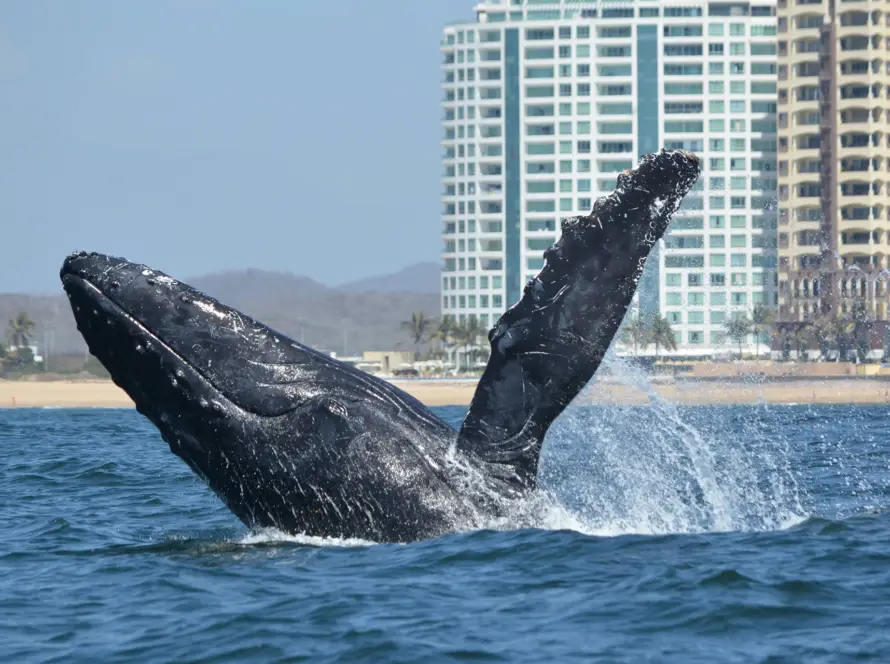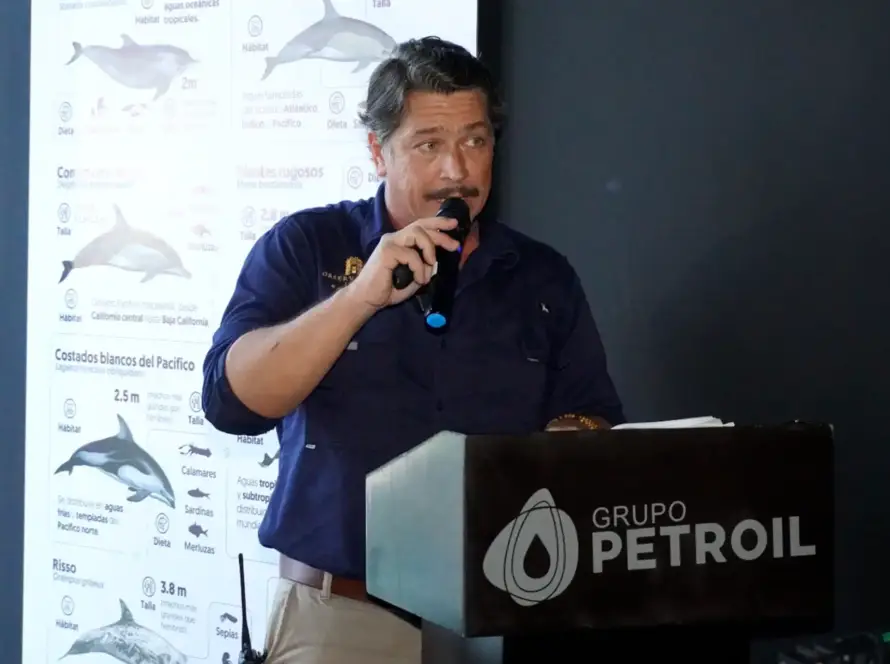This museum space is intended to be a bridge that connects people with the sea, the whales and environmental education in favor of their conservation.
The replica of the skeleton of a nearly 50-foot blue whale is the first thing that catches the eye upon entering the construction area of the National Whale Museum, Munba, within the area of the 1873 Observatory tourist park.
The director of this project is the oceanologist specialized in whales, Óscar Guzón Zataráin. He determined the objective of this museum and designed the visual story to be told to visitors.
"Munba is a non-profit civil association and the general mission is education for the conservation of whales and dolphins. We focus only on cetaceans, which are whales and dolphins, and some other species of marine mammals that, because of their relevance as part of the country's marine biodiversity are important, such as sea lions," he explained.
It is estimated that 12 species of marine mammals are present in Mexico, two of which, cetaceans and sirenids (sea cows), live in national waters, according to data from the Federal Attorney's Office for Environmental Protection (Profepa).

"The idea is for the enclosure to be a magical place, to be able to tell the natural history of whales and dolphins, from who they are, where they originate and how they evolved in the oceans, to how they live, what they eat, how they survive in the different marine habitats," stated Guzón Zataráin in an interview with Son Playas.
To achieve this, he added, during the tour there will be sensory experiences and interactive exhibits that will complement the largest exhibition of cetacean skeletons in Mexico and Latin America.
Also read: Mazatlan will have a National Whale Museum
Origin of skeletons
This exhibition of skeletons is based on a collaboration agreement with the Whale and Marine Science MuseumThis agreement will make it possible to obtain on loan 29 skeletons from its osteological collection, which will join others already in the locality.
"Paco Gómez (director of the La Paz museum) has already been here, he has been a great support because first of all he is providing us with much of the content of Munba, with a collaboration between the two museums that extends beyond the bones," he said.
Mazatlan has a privileged location, as does Munba, to disseminate knowledge of the marine megafauna. From the top of Cerro del Vigía, where the museum is located, you can see the fiscal dock and a good part of the bay of this Sinaloa destination.
"You see this, you're here and you can see exactly the human-cetacean interaction, how we're connected to the whale and dolphin habitat. We have almost every threat walking in front of us, in plain sight," he said.
You are at threats are not always noticeable he explained, but the fact is that whales suffer when entangled in fishing gear or from the increasing impact of maritime traffic on their migratory routes.
In addition to directing the museum, Oscar Guzón, a doctoral student in aquatic sciences and resources, will incorporate the knowledge gained from 20 years dedicated to the study of whales in Mazatlán.

Architecture born from recycling
Munba also stands out for its architecture and construction elements. Designed by Mexican architect Alejandro D'Acosta, who is known for using waste materials, especially from the immediate surroundings, as a way of addressing the environmental impact of his work. This is the reason why used shipping containers were incorporated in the construction of this new museum space.
"That part is very important. They are marine containers, those that transport materials between continents. In a way, it is an element that can be part of one of the threats, which is maritime traffic, and now it is embedded here, it gives life, it gives shelter to the museum. The idea is to promote a culture of sustainability through these elements," explained Guzón Zataráin.
The containers were also used to set up El Erizo, a multimedia projection space.
"It will be an expansive or infinity experience with mirrors and high-fidelity screens and we will try to maintain an itinerant content, inviting local, national and international artists to intervene in this space to promote the conservation of life in the sea," he said.
Also read: Five things to know if you want to see whales



Whales need more space
Óscar Guzón Zataráin has dedicated his life to researching whales, disseminating their importance and promoting their conservation in a global context that threatens their survival.
"You have to remember that no matter how many whales there are there are never going to be too many. During the industrial whaling 200 years ago, all whale populations were hunted at over 90%. So, many are barely recovering," he said.
The cetacean specialist mentioned that there is evidence of population growth of humpback whales from the North Pacific area, which arrive in Mazatlan.
"But this also means that the more whales there are, the more space they need, and that space is already occupied by us. We have to learn to coexist, to give them enough space so that they can fulfill their reproductive, migration, breeding and feeding needs," he specified.
And when talking about occupied spaces, he refers to recreational shipping, industrial maritime traffic, large cargo ships coming from China back and forth, which bring goods and are vital to the global economy, but have a negative impact on whales and their migratory routes.
"In different parts of the world, different initiatives are being worked on to support changes, for example, so that whales have free spaces to be able to transit on their routes. In Mexico we are involved in these issues, especially because we have deep-sea ports, both in the Gulf of Mexico and in the Pacific," he said.
Also read: These are the migratory routes of whales and the dangers they face

If whales are doing well, so are people
According to the World Wildlife Fund, WWFWhales contribute to the fertilization of marine ecosystems, especially with their migrations of thousands of kilometers through the so-called blue corridors.
They are also considered allies against global warming, as their feces boost the production of phytoplankton, which captures 40% of all carbon dioxide produced globally and at the same time generates more than half of the oxygen in the atmosphere.
Because of the multiple functions they perform, these marine mammals are considered umbrella species, that is, they function as a channel for the conservation of the entire associated ecosystem: if the species is healthy, this ensures that its environment is in good health, according to the international organization.
And precisely what whales contribute to the world, why it is important to conserve them, what is the role of these animals in marine ecosystems, in the production of oxygen and carbon dioxide sequestration, is part of the information that visitors to the Munba will leave with.
"This is going to be a bridge to the sea, we are going to be able to continue to promote best whale watching practices through the museum. Whales are watched everywhere in the world. Wherever there are whales, there are people wanting to go and see them, and the thing is that if you leave this museum you will want to do so", says Oscar Guzón Zataráin.




